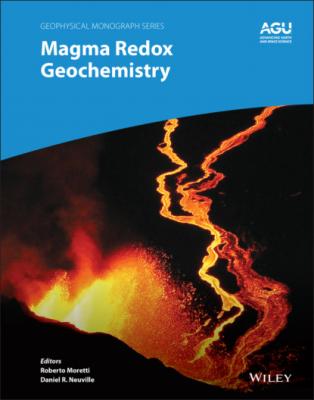Magma Redox Geochemistry. Группа авторов
Читать онлайн.| Название | Magma Redox Geochemistry |
|---|---|
| Автор произведения | Группа авторов |
| Жанр | Физика |
| Серия | |
| Издательство | Физика |
| Год выпуска | 0 |
| isbn | 9781119473244 |
Figure 2.2 LogfO2 (normalized to the FMQ buffer) calculated for mantle peridotite and eclogite xenoliths using oxy‐thermobarometers by Stagno et al. (2013; 2015; 2019). The blue and red lines are the oxygen fugacity calculated along a cratonic geotherm (~44 mW·m‐2) where diamonds (graphite) coexist with carbonatitic and kimberlitic melts, respectively. The purple line is the FeNi precipitation curve (Frost and McCammon, 2008), while the blue dashed line crosses the fO2 at which water is the main component of stable C–O–H fluids. At fO2 ≤ FMQ-3 log units fluids become increasingly CH4‐rich
(modified from Luth and Stachel, 2014).
2.3.2. Is the fO2 of the Transition Zone and Lower Mantle Recorded by Sublithospheric Diamonds?
Since no direct mantle rocks are available from depths greater than 200–250 km, the only tools to investigate the oxidation state at transition zone/lower mantle conditions and possible redox melting over time, in addition to the aforementioned mantle‐derived magmas, are experimental data combined with analyses of inclusions in natural sublithospheric diamonds. These diamonds, brought to the surface by kimberlitic eruptions, are often characterized by mineral inclusions representative of the transition zone and lower mantle (cpx, ringwoodite; majorite, NAL, Ca‐ferrite phase, bridgmanite, ferropericlase; Stachel et al., 2005; Pearson et al., 2014) that show geochemical evidence of the passage of oxidized C‐O‐H‐rich fluids from which they might have originated (Kaminsky, 2012; Kiseeva et al., 2018; Smith et al., 2016; Thompson et al., 2016; Walter et al., 2008). Recent discoveries of hydrous ringwoodite (Pearson et al., 2014) and ice‐VII (Tschauner et al., 2018) in diamonds from the transition zone further highlight the role of volatiles (other than C) bearing fluids in sublithospheric diamond formation. The origin of these fluids is often linked to subducted slabs widely accepted to be responsible for the oxygenation of the mantle from its initially reduced state in the wake of accretion and core formation (Lécuyer & Ricard, 1999). However, recent experimental investigations show that minerals like cpx, garnet, and majorite, which contain redox‐sensitive Fe and are the main constituents of metamorphosed oceanic crust, can incorporate large amounts of Fe3+ as result of increasing depth (i.e., pressure) and thus become significantly oxidized (Rohrbach et al., 2011; Kiseeva et al., 2018; Stagno et al., 2015, 2019). Such form of oxygen sequestration from minerals would result in reduced portions of the subducted slab, with diamond being the stable C form (i.e. redox freezing) and might explain the finding of large amounts of Fe3+ in majoritic inclusions trapped in diamonds (Kiseeva et al., 2018) as well as the occurrence of nanometer‐sized Mg‐ferrite inclusions in ferropericlase from superdeep diamonds (Harte et al., 1999; Wirth et al., 2014). While these natural observations open a scenario of a more oxidized rather than reduced Fe0‐saturated deep mantle as shown by thermodynamic and experimental predictions (Frost et al., 2004; Hu et al., 2019), some questions remain, such as the possibility that these inclusions do not reflect the whole‐mantle redox state but only local redox reactions.
2.3.3. Temporal and Spatial Evolution of the Redox State of the Asthenospheric Mantle
The oxygen fugacity of the ambient mantle, source of MORBs, and the deep convecting mantle sporadically sampled by plumes and kimberlitic melts both control the speciation of volatiles and hence the locus of the peridotite solidus and the nature of the melts that are produced (Wyllie & Huang, 1975; Canil & Scarfe, 1990; Green, 2015). In addition, mantle fO2 plays a role in mantle rheology and therefore dynamics, whereby more oxidizing conditions enhance concentrations and mobilities of lattice defects, resulting in a viscosity reduction (Cline et al., 2018). Given its importance, great efforts have been made to constrain mantle redox evolution, which is necessary to accurately capture mantle geodynamics and melting behaviour. For example, redox melting, whereby upwelling mantle will intersect the equilibrium C(graphite/diamond) + 2Fe2O3(melt) = 4FeO + CO2 (both in the melt) due to increasing fO2 with decreasing pressure, will occur in the depth interval of ~150 to 120 km at modern mantle
